Golf Rules
Valid through 2025
Special Olympics New Hampshire has created this set of rules based on the rules outlined by Special Olympics International as well as the rules outlined by the International Golf Federation, the international governing body for golf.
These rules shall be used to govern all Special Olympics New Hampshire Golf competition through the end of 2025 when we next review these rules.
Events Offered
- Individual Skills Competition
- Unified Sports Alternate Shot Team Play Competition (5 Holes)
- Unified Sports Alternate Shot Team Play Competition (9 Holes)
- Unified Sports Alternate Shot Team Play Competition (18 Holes)
- Unified Sports Aggregate Shot Team Play Competition (18 Holes)
- Individual Stroke Play Competition (9 Holes)
- Individual Stroke Play Competition (18 Holes)
Registration
- Golfers may register for one event.
- Each Local Program must have at least one head coach (who may also be a player) registered for the tournament.
Divisioning
- Local Programs will submit scores, including for Individual Skills athletes, through Agon.
- Score cards with course indexes and slope ratings will need to be emailed to FallonW@sonh.org. The course indexes and slope ratings will be used to division competition.
Equipment
- A valid driver’s license is needed to drive a golf cart.
- Each player is responsible for providing his/her own equipment, including a set of clubs (no more than 14 clubs), golf bag, golf balls, tees, divot repair tool and ball marker.
- Teams (comprised of an athlete and a Unified Partner) may share clubs provided that the total number of clubs carried by the team does not exceed 14.
- Athletes must wear golf attire like khakis and a golf shirt. Jeans are not permitted.
- Athletes must wear golf shoes or sneakers.
Competition
General rules
- Teams shall consist of one athlete with an intellectual disability and one Unified partner without an intellectual disability.
- For ALTERNATE SHOT TEAM PLAY COMPETITION, an athlete and Unified Sports partner play one ball. The players play alternately from the teeing grounds and then alternate strokes until the ball is holed or until 10 strokes have been played.
- For AGGREGATE SHOT TEAM PLAY COMPETITION, each player plays his/her own ball; the combined score of the two balls will be the score for the hole.
- For INDIVIDUAL STROKE PLAY COMPETITION, athletes play golf by themselves and compete against other athletes on an individual stroke play basis for 9 or 18 holes.
- Before the round, each team determines whether the athlete and partner tee off from the even or odd numbered holes. Athletes and partners will tee off from the front tees on their respective driving holes.
- All players will play from preferred lies in their own fairway. The ball can be placed within one club length and no nearer the hole. However, if the ball is in the rough or a bunker, its lie cannot be improved; it is played where it is.
- Players must pick up the ball after ten strokes; the score for that hole will be 10x.
- A swing and miss counts as a stroke.
- Out-of-Bounds
- If Player A hits the ball out-of-bounds (outside the white markers), Player B will re-tee from the tee box. This is loss of stroke and distance because it is re-teed from the same spot; after teeing off, the team will lay 3.
- After teeing off, if it cannot be determined whether Player A’s tee shot is in bounds, Player B will hit a provisional tee shot. If the ball is in-bounds, the provisional ball is picked up and not played.
- Hazard
- If Player B loses his/her ball or it goes into a hazard (marked by red or yellow markers), Player A places a new ball near to where it was lost. One stroke penalty is accessed.
- If the ball was in the rough, the next shot will also be played in the rough.
- If at the end of the round there is a tie for first place, the following protocol is followed:
- The player or team with the fewest 10x’s is declared the winner (first place).
- If it is still a tie, the matching of scorecards occurs beginning with hole number 1. Proceed through the round until the tie is broken.
- All other ties shall remain as ties; both players/teams who have tied should be presented with the same award and place of finish.
INDIVIDUAL SKILLS
- The purpose of the Individual Skills Competition is to allow athletes to train and compete in basic golf skills they’ve acquired with the intention of learning skills necessary to play 5-hole competition.
- Individual Skills Competition is comprised of six events:
- Short Putt
- Long Putt
- Chip Shot
- Pitch Shot
- Iron Shot
- Wood Shot
- The athlete’s final score is determined by adding together the scores achieved in each of these six events. Athletes will be pre-divisioned according to their total scores from these six events:
Short Putt
The athlete will have five attempts to putt the ball at the hole from a line 2 meters (6.6 feet) from the hole, scoring points according to where the ball comes to rest.
- Scoring:
- A swing and a miss count as one attempt, and the athlete receives a score of zero.
- The athlete will score one point for attempting a stroke and striking the ball, but it does not go into a circle.
- Two points are scored if the ball stops on or within the 1.5 meters (4.9 feet) circle.
- Three points are scored if the ball stops on or within the 0.5 meter (1.6 feet) circle.
- If the ball goes in the hole, a total of four points will be awarded for that attempt.
- The Short Putt score shall be the sum total of the five attempts. (Maximum of 20 points)
- Layout (see diagram below):
- A target hole is selected, and two circles are placed around the hole. The first circle shall have a radius of 0.5 meter (1.6 feet) and the second shall have a radius of 1.5 meters (4.9 feet) from the hole.
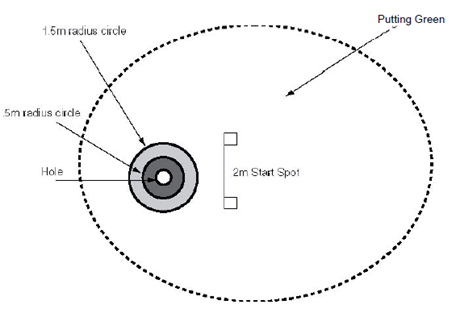
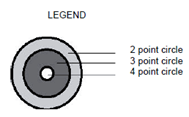
Long Putt
The athlete will have five attempts from a marked spot, 8 meters (26.2 feet) from the hole.
- Scoring:
- The athlete will have five attempts to putt the ball at the hole from a spot 8 meters (26.2 feet) from the hole, scoring points according to where the ball comes to rest.
- The athlete will score one point for attempting a stroke and striking the ball, but it does not go into a circle. (A swing and a miss count as one attempt, and the athlete receives a score of zero).
- Two points are scored if the ball stops on or within the 1.5 meters (4.9 feet) circle.
- Three points are scored if the ball stops on or within the 0.5 meter (1.66 feet) circle.
- If the ball goes in the hole, a total of four points will be awarded for that attempt.
- The long putt score shall be the sum total of the five attempts.
- Layout (see diagram below):
- A target hole is selected, and two circles are placed around the hole. The first circle shall have a radius of 0.5 meter (1.6 feet) and the second shall have a radius of 1.5 meters (4.9 feet) from the hole.
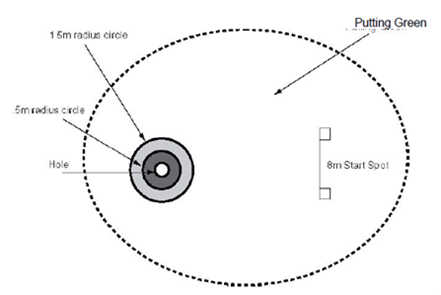
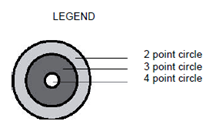
Chip Shot:
The athlete is instructed to chip the ball at a designated hole, getting it as close to the hole as possible.
- Scoring:
- The athlete will attempt five shots at the target, scoring points according to where the ball comes to rest.
- The athlete will score one point for attempting a stroke at and striking the ball, but the ball does not finish in a circle. (A swing and a miss count as one shot and the athlete receives a score of zero for that shot).
- Two points are scored if the ball comes to rest inside the 6-meter (19.7 feet) circle around the hole.
- Three points are scored if the ball comes to rest inside the 3-meter (9.8 feet) circle around the hole.
- Four points are scored if the chip shot comes to rest in the hole.
- The total score from the five attempts will be the athlete’s final score for the Chip Shot. (Maximum of 20 points)
- Layout (see diagram below):
- A chipping area is set up which includes a 3-meter (9.8 feet) by 3-meter (9.8 feet) square hitting area 14 meters (49.9 feet) from the hole. The chipping area should be 2 meters (6.6 feet) from the edge of the green.
- A 3-meter (9.8 feet) radius circle and a 6-meter (19.7 feet) radius circle will be placed around the hole.
- A safely marked hitting area, 3-meter (9.8 feet) by 3-meter (9.8 feet) square, chalk and marker.
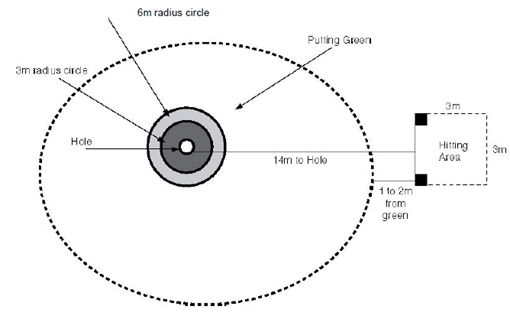
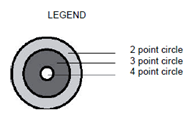
Pitch Shot:
The athlete shall make five attempts. The athlete is instructed to pitch the ball over the barrier at the designated target area.
- Scoring:
- The athlete will attempt five shots at the target, scoring points according to where the ball lands.
- Athletes will score one point for attempting a stroke at and striking the ball, but it does not land in a target area. (A swing and a miss count as one shot and the athlete receives a score of zero for that shot).
- Two points are scored if the ball goes over the barrier and between the upright poles.
- Three points are scored if the ball goes over the barrier and lands inside the 12-meter (39.4 feet) circle and rolls out, or if the ball lands outside the 12-meter (39.4 feet) circle and comes to rest inside the circle.
- Four points are scored if the ball over the barrier and lands inside the 12-meter (39.4 feet) circle and comes to rest inside the circle.
- The Pitch Shot score shall be the sum total of the five attempts. (Maximum of 20 points)
- Layout (see diagram below):
- A target area shall be a circle with a 6-meter (19.7 feet) radius.
- The distance from the hitting area to the 1-meter (3.3 feet) high barrier shall be 5 meters (16.4 feet).
- The distance from the 1-meter (3.3 feet) high barrier to the target area shall be 5 meters (16.4 feet).
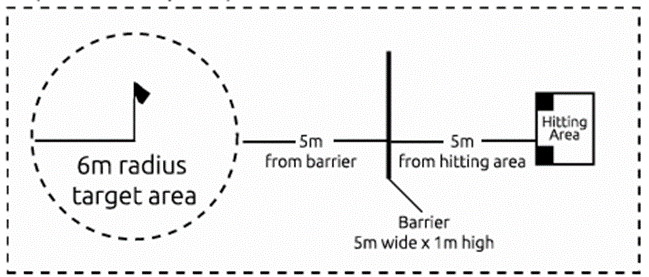
Iron Shot:
The athlete will have five attempts at the target from a designated hitting area, scoring points according to where the ball comes to rest, trying to keep the ball within the boundary markers and achieving a distance of more than 90 meters. Athletes may use an Iron or Hybrid/Rescue Club for either an Iron shot, but not both.
- Scoring:
- The athlete will attempt five shots at the target, scoring points according to where the ball comes to rest.
- Athletes will score one point for attempting a stroke at and striking the ball, but not within the boundary markers or designated distance. (A swing and a miss count as one attempt and the athlete receives a score of zero for that shot).
- Two points are scored for a ball that comes to rest between the 30-meter and 60-meter lines within the 35-meter-wide boundary lines.
- Three points are scored for a ball that comes to rest between the 60-meter and 90-meter lines within the 35-meter-wide boundary lines.
- Four points are scored for a ball that comes to rest beyond the 90 meters line within the 35-meters wide boundary lines.
- The athlete’s score for the Iron Shot shall be the sum total of the five attempts. (Maximum of 20 points)
- Layout (see diagram below):
- The athlete is instructed to hit the ball from the teeing area toward a designated flag in the hitting area, trying to keep the ball within the boundary markers and achieving a distance of more than 90 meters.

Wood Shot:
The athlete will have 5 attempts to hit the ball off a tee, a mat or the ground from the teeing area toward a designated flag in the hitting area, trying to keep the ball within the boundary markers and achieving a distance of more than 120 meters. Athletes may use a Fairway Wood, or Driver and if they did not use a Hybrid/Rescue Club for their iron shot, then they can use it for the Wood shot.
- Scoring:
- The athlete will attempt five shots at the target, scoring points according to where the ball comes to rest.
- The athlete will score one point for attempting a stroke at and striking the ball, but not within the boundary markers or designated distance. (A swing and a miss count as one attempt, and the athletes receives a score of zero for that shot).
- Two points are scored for a ball that comes to rest between the 60-meter and 90-meter lines within the 50-meter-wide boundary lines.
- Three points are scored for a ball that comes to rest between the 90-meter and 120-meter lines within the 50-meter-wide boundary lines.
- Four points are scored for a ball that comes to rest beyond the 120-meter line within the 50-meter (164.041 feet) wide boundary lines.
- The athlete’s score for the Wood Shot shall be the sum total of the five attempts. (Maximum 20 points)
- Layout (see diagram below):
- A target flag and eight cones or other visible markers identify distance locations.

Disqualification & Protest
In stroke play, a penalty must not be rescinded, modified or imposed after the competition has closed. A competition is closed when the result has been officially announced.
Exceptions: A penalty of disqualification must be imposed after the competition has closed if a competitor:
- Returned a score for any hole lower than actually taken for any reason other than failure to include one or more penalty strokes, that before the competition closed, he/she did not know he/she had incurred.
- Knew, before the competition closed, that he/she had been in breach of any other rule for which the penalty is disqualification.
- For tournaments and competitions, coaches can assume the role of a caddie, with the understanding they will relinquish their coach privileges (that is, the ability to file a protest) during the competition.
